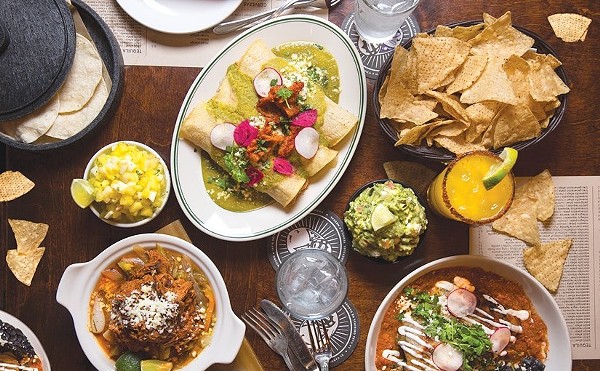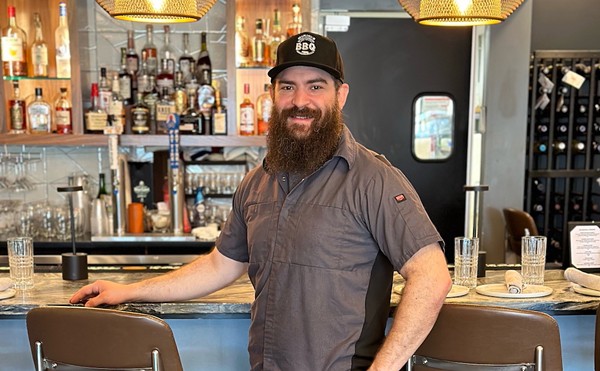Ganesh obviously takes his responsibilities seriously, if Cafe Tandoor's success over the past seven years is any indication. Many members of Cleveland's Indian community consider Raj Singh's Cleveland Heights restaurant to be the city's best source of northern Indian "home cooking," while non-Indian culinary adventurers praise it for its well-balanced and exotically flavored preparations of vegetables, fruits, yogurt, and meats. The fine food, served in a serene setting of candlelight and fresh flowers, gives the totally nonsmoking restaurant an air of tranquility and comfort.
Cafe Tandoor's large but exceptionally well-organized menu reads like a sort of gustatory atlas, starting with a brief narrative tracing the history of tandoori (clay oven) cooking, and concluding with a glossary of ingredients common to Indian cuisine.
Between those pages is a broad selection of appetizers; clay-oven-baked seafood, chicken, and lamb specialties; curry dishes; vegetarian selections (many Hindus eat nothing that moves under its own power); basmati rice creations; an assortment of freshly baked tandoori breads; condiments and chutneys; sweets; and beverages. Everything, including the spice blends, is made fresh daily.
Milk figures prominently in the Indian diet, both as a protein source and to offset what are often fiery-hot flavors. It's the primary ingredient in staples like paneer, a mild, firm-textured cheese similar to ricotta; dahi (yogurt); and raita (yogurt flavored with chopped vegetables or fruits). But the best of milk's many contributions to the Indian kitchen may be lassi, a traditional beverage of yogurt, crushed ice, sugar, and flavorings like vanilla, rose water, or mango pulp, that may either accompany a meal or serve as a between-meal snack.
The cold sweet-and-sour tang of a thick, creamy lassi is the perfect counterpoint for the mouthshaking dishes that flow out of Cafe Tandoor's kitchen. But don't be scared: While many Indians expect a degree of heat in their food that would send Westerners running for a snowbank, head chef Bishori Lal Bhardwaj keeps the fire down to a gentle simmer unless instructed to do otherwise. This allows those of us with cornflake-bred palates to savor the complex blends of cloves, cardamom, cinnamon, garlic, red chilies, black peppercorns, ginger, and turmeric that strike the signature flavor notes of Indian cooking--without forcing us to continually wipe beads of sweat from our brows.
A serving of Cafe Tandoor's mango chutney provides a great example of the complexity of Indian flavorings, even when the heat is turned down to a hum. The thick, golden jam looks a little like orange marmalade and initially hits the tongue like a smooth fruit compote. But after a second, the soothing sweetness is replaced by a wave of intensely sharp ginger, rolling across the tongue like a riptide, popping open the eyelids, and sending shock waves through the sinuses. On the heels of the ginger, a slow, steady heat builds up then fades, leaving the diner slightly giddy but eager to experience it all again. (Yes, that was me piling mango chutney on flatbread, just to get that rush one more time.)
In fact, flatbreads (with or without chutney) are another mainstay of the Indian cupboard and were used until fairly recently in rural India as utensils for scooping up stew-like dals and curries. (Nowadays, I am told, Western-style flatware is more or less commonplace throughout the country.) Cafe Tandoor bakes a variety of breads in its traditional clay oven, including roti, a round, flat, unleavened whole-wheat bread; paratha lachhedar, a multilayered, buttery whole-wheat bread; and naan, a chewy, slightly leavened white-flour bread.
While a loaf of roti looks very much like pita bread, its fresh-from-the-oven taste and texture is lighter and more delicate. Crisp and brown on the outside, the bread is steamy and moist, and just a little bit sweet, on the inside. Even better is Cafe Tandoor's onion kulcha, naan dough into which bits of sweet, tender onion have been kneaded before baking. Thicker than roti and slightly salty, a round loaf of the herb-scented bread, something like focaccia, could easily be a meal by itself.
A mixed platter of appetizers (vegetarian or non-vegetarian) is a neat way to sample several dishes at once. The non-vegetarian mix includes a big, triangular samosa, a flaky pastry stuffed with a soul-stirring blend of finely ground lamb, crisp sweet peas, cashews, raisins, and spices. We also liked the moist cylinders of marinated ground lamb (seekh kebab), but we thought the cubes of battered chicken pakora and yogurt-marinated chicken tikka were overcooked and dry. Still, when doused with plenty of the dark, sweet-but-acidic date-and-tamarind chutney or the creamy mint-yogurt chutney that accompanied them, even those two tidbits became more palatable.
Entrees at Cafe Tandoor come to the table in traditional fashion, in oval brass serving bowls called balti. Each order is large enough for sharing--which, considering all the tempting offerings on the menu, is the only way to go. By adding a platter of basmati rice "for the table," a party of two or more can easily order up a small smorgasbord for sampling.
An entree of rogan josh, a traditional lamb curry, was one of the best we have sampled locally. Although the meat was notably strong-flavored, it was falling-apart tender and robustly seasoned with a zippy garam masala, a traditional blend of pepper, cumin, cloves, cardamom, and cinnamon popular in northern India. The lamb and its thick, brown sauce were delicious scooped up with pieces of roti or spooned over the firm, nutty rice.
My vegetarian dining companions, who are from Calcutta, and I were also swept away by a delicious navaratana curry, a light vegetarian dish whose name means "nine jewels." The remarkable dish included eggplant, peas, mushrooms, plump raisins, tomatoes, and cashews in a thin tomato-based sauce that rang out with both sweet and sour flavors, punctuated with the slightly crisp texture of the vegetables and nuts, and just a hint of heat.
Another vegetarian selection, matar paneer, was also a palate-pleaser. Four substantial wedges of firm, fried ricotta-like cheese were rather bland by themselves, but in their complex, zesty sauce of tomatoes, peas, spices, and cream, they had us licking the plate.
My Indian companions thought an order of chana pindi (a simple dish of chickpeas sauteed with spices and tomatoes) was underseasoned. Still, our less-thrill-seeking Western taste buds enjoyed the mildly flavored blend of legumes and vegetables in a light, tomato-based sauce.
Indians apparently have a massive sweet tooth, and they typically end their late-evening meals with treats like rasmalai (cottage-cheese-like dumplings in thickened, sweetened milk); kheer (basmati rice cooked in sweetened milk, flavored with cardamom, and studded with raisins and almonds); and gulab jamun (balls of deep-fried cake drenched in a thin sugar syrup).
Our bowl of kheer at Cafe Tandoor was thin, cold, sweet, and comforting, and left us feeling like well-fed children in some far-off nursery. The gulab jamun--two small balls of tender fried cake floating in warm syrup--was simple and sugary, and seemed guaranteed to produce sweet dreams. If we had had more room in our overstuffed tummies, we might have also tried homemade mango, pistachio, coconut, or vanilla ice cream, with or without slices of fresh mango. "Maybe next time," we murmured contentedly.
Throughout our meal, service was unobtrusive, efficient, and accommodating, although the nature of the prepared-to-order dishes means the wait for entrees can be lengthy. The menu suggests expecting to wait half an hour for a meal to arrive, though our beverages and appetizers quickly appeared and kept us happily occupied until the main courses came.
Like American restaurants that offer after-dinner mints to departing guests, Indian restaurants set out bowls of whole spices to settle the stomach and freshen the breath of diners on their way home. Generally, the proffered item is fennel seed, a tiny, highly fragrant, and slightly bitter herb that tastes something like licorice. If you are lucky, colorful candy-coated fennel seeds, for those whose sweet tooth perseveres, will also be offered. (Warning: these crunchy little devils are positively addictive.) At Cafe Tandoor, the selection includes both of the above, plus quartz-like crystals of sugar and whole cardamom pods and cloves--which must be sucked upon gently and never, ever chewed.
I learned that the hard way, ending one of my earlier meals by casually chomping down on a cardamom pod as I walked out the door. Judging from the reaction of my Indian friend, I looked pretty hilarious as I jumped around in the parking lot, spitting out pieces of seed like a tobacco-chewing cowboy.
Is it any wonder Ganesh was smiling?
Cafe Tandoor. 2096 South Taylor Road, Cleveland Heights. 216-371-8500. Lunch, dinner, and carryout; call for hours.
Non-Vegetarian Mixed Appetizer Platter $7.95
Rogan Josh $10.95
Matar Paneer $7.95
Navaratana Curry $8.95
Chana Pindi $6.95
Roti $2.00
Onion Kulcha $3.00
Mango Chutney $1.50
Gulab Jamun $3.50
Kheer $3.50
Lassi $2.
00









